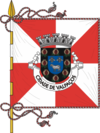Valpaços
| Valpaços | |||
|---|---|---|---|
| Municipality | |||
|
|||
 |
|||
| Coordinates: 41°36′35″N 7°18′44″W / 41.60972°N 7.31222°WCoordinates: 41°36′35″N 7°18′44″W / 41.60972°N 7.31222°W | |||
| Country |
|
||
| Region | Norte | ||
| Subregion | Alto Trás-os-Montes | ||
| Intermunic. comm. | Alto Tâmega | ||
| District | Vila Real | ||
| Parishes | 25 (see text) | ||
| Government | |||
| • President | Amílcar Almeida (PPD-PSD) | ||
| Area | |||
| • Total | 548.74 km2 (211.87 sq mi) | ||
| Elevation | 515 m (1,690 ft) | ||
| Population (2011) | |||
| • Total | 16,882 | ||
| • Density | 31/km2 (80/sq mi) | ||
| Time zone | WET/WEST (UTC+0/+1) | ||
| Postal code | 5430 | ||
| Area code | 278 | ||
| Patron | Nossa Senhora da Saúde | ||
| Website | http://www.valpacos.pt | ||
Valpaços (Portuguese pronunciation: [ˌvaɫˈpasuʃ]) is a municipality in northern Portugal. The population in 2011 was 16,882, in an area of 548.74 km².
The first documents that cite Valpaços date back to the 12th century. Its toponymy evolved from pre-national settlements, and started as a small enclave inhabited by nobles and signeurial family estates, attracted by the privileges of colonial settlement so close to the Spanish border. The nascent Portuguese community was susceptible to attacks from Spain, who maintained their land claims to the Portuguese territory. The establishment of border settlements fixed the border.
Historically, Vale de Paço (and later Vale de Paços until the 19th century) was an area with roots in the Roman period of settlement, yet influenced by Germanic settlers before Portugal became a Kingdom.
The most important event in the regions history occurred in the 19th century. On 16 November 1846, during the Patuleia conflict, a movement that was apolitical turned bloody, resulting in the deaths of 200 people, before the wave proceeded into the lands of Murça.
Valpaços is located in the northern interior of Portugal in the Alto Trás-os-Montes region, and part of the district of Vila Real. It is confined in the north by the municipality of Chaves, to the east by Mirandela and Vinhais, to the south by Murça and Mirandela and in the west by Chaves and Vila Pouca de Aguiar.
From north to south, the Transmontanan relief is exemplified by planar stretches of the Iberian Meseta, with altitudes between 700–800 metres above sea level, tending to have a regular profile north of the Douro River.
...
Wikipedia


